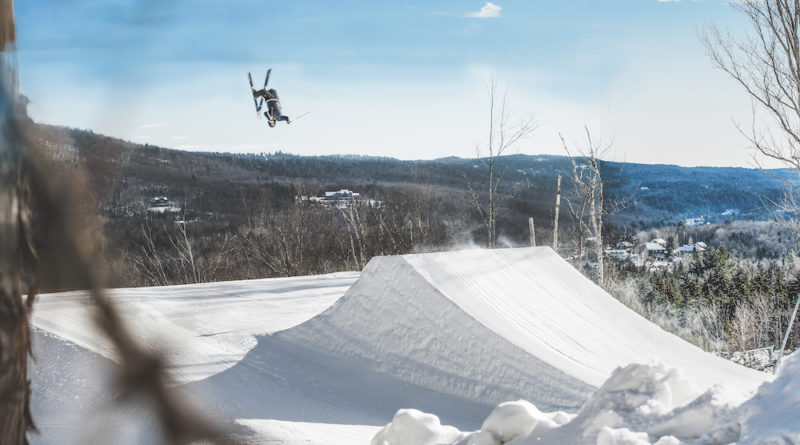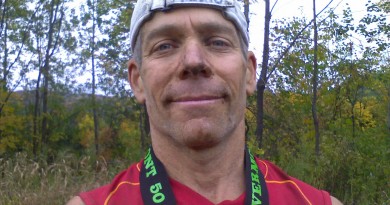2019 Athletes of the Year
In 2019, these Vermont athletes made the world stage in a big way.
BY LISA LYNN & ABAGAEL GILES
Each December, when it comes time to choose our Athletes of the Year, we have a hard time narrowing the field. This year, the bar was set higher than in many years by athletes such as Elle Purrier, a farmer’s daughter who ran one of the fastest miles ever recorded by a woman, and Mac Forehand, who at 17, won the overall slopestyle skiing World Cup. Here, our tribute to the Vermont athletes who put the world on notice in 2019.
Elle Purrier, Montgomery, VT
On Sunday, Sept. 7, 2019, running star Jenny Simpson, Vermont’s Elle Purrier and a pack of elite professional women runners toed the line at the start of the 39th running of the Fifth Avenue Mile in New York City. More than 9,000 runners were behind them and crowds of spectators lined the avenue.
Two minutes into the race, Simpson, 33, a former world champion in the 1,500 meters and the 2016 Olympic bronze medalist, had pulled to the front. Announcers speculated that Simpson, who normally holds back, was going fast earlier than usual in hopes of breaking her own 2017 time of 4:16:6 (a time that
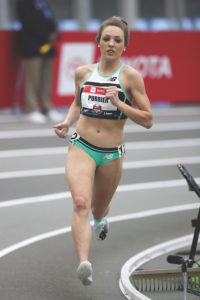
tied a record set by Patti Sue Plumer in 1990) which would make this her eighth win.
But a few steps ahead of Simpson was her relatively unknown New Balance teammate, Elle Purrier. Elle (pronounced ‘Ellie’), 24, grew up on a dairy farm in Montgomery Center, Vermont and 2019 was her first full year racing as a pro.
Simpson began to pick up the pace and Purrier kept matching her until the two had put the width of a full city cross-street between them and the pack. They crossed the finish neck and neck, with Simpson just barely eking out the win from her teammate. Simpson, finishing in 4:16:1, broke her own record. But so did Purrier, who finished in 4:16:2.
Those times put both women among the seven fastest mile times ever recorded by women–records largely set on tracks, and three of which were set prior to 1996. The world record for a women’s mile is now 4:12:33, set by Sifan Hassan of the Netherlands on a track in Monaco in July, 2019.
“I hadn’t really planned to enter the Fifth Avenue Mile,” said Purrier by phone from Hawaii this December, just after finishing third of all elite runners (both men—who started 28 seconds back—and women) and winning the women’s Merrie Mile in Honolulu.
“My focus last fall was on training for 5,000 meters in the World Championships in Doha, which was two weeks after the Fifth Avenue Mile,” she said. There, at the World Championships in Doha, Qatar in October, Purrier earned the last spot in the 5,000-meter finals. In the World Championship finals she finished 11th overall, the second American.
It’s been an amazing year for a woman who six years ago was waking up before dawn to help with chores on the farm. “I really didn’t run much or even like running as a kid—I liked basketball and other sports better,” she said.
But farmwork built strength: “I think the hardest thing was loading 100-lb bales of hay,” recalls Purrier, who is 5 feet 5 inches and weighs around 130 lbs.
After Purrier won multiple high school, state, New England and Northeast regional championships in track and field, coaches from Dartmouth and a number of other top schools came knocking.
“Hopp, (Robert Hoppler, cross-country coach at University of New Hampshire), came to visit me at home,” she remembers. “He came from a blue-collar background as well and really just seemed to get me. It was close to home and I really liked the school. It wasn’t until I got to UNH and was part of the team there that I really thought of myself as a ‘runner,’” she said.
At UNH, Purrier became an 11-time All American, the NCAA mile champion and the most decorated athlete in the school’s history. After graduating in 2018, Purrier turned down offers to go pro that would have taken her to the Pacific Northwest and chose to go with New Balance, where former Dartmouth coach, Mark Coogan, is now coach. “I wanted to stay close to home and Mark was friends with Hopp so he knew me, too.”
Staying close to home this year had another benefit: in spring of 2019 her high school sweetheart and neighboring farmer, Jamie St. Pierre, showed up at her parent’s farm. In one hand, he had a calf—a Brown Swiss cow—and the other a ring. The two have plans to marry in the fall of 2020.
When asked about her other best moments from 2019, Purrier doesn’t hesitate. It wasn’t finishing 11th in the World Championships, setting new personal best times or nearly winning the Fifth Avenue Mile—it was finishing third in the 5,000 meters in the 2019 Toyota USATF Outdoor Championships in July, which qualified her for the Worlds.
“Just knowing I was qualifying for the World Championships and knowing I was part of the U.S. Team was pretty exciting,” said Elle. “And then just going to the Worlds and learning so much from these other racers I’ve looked up to,” she said.
With the Olympic trials coming up in June, soon they may be learning from her. —Lisa Lynn
Sophie Caldwell and Jessie Diggins, Peru & Stratton, VT
When Jessie Diggins and then-teammate Kikkan Randall won an Olympic gold medal in the women’s sprint free in PyeongChang, it was far from a fluke. The pair may have been the anchors of the U.S. Women’s Cross Country Ski Team, but it was a team with deep talent, and much of that talent was rooted in Vermont. So much, in fact, that Diggins now calls southern Vermont home, owns a condo here and trains here all summer with fellow team members (many part of the Stratton Mountain School T2 Elite Team), who are stars in their own rights, including Sophie Caldwell of Peru and Julia Kern, now at Dartmouth.
When Randall, who has been battling cancer, retired many wondered how the women’s team would fare.
After winning the gold and then publishing a book, Diggins was back at it last season and going into the 2019/20 season, is looking even stronger.
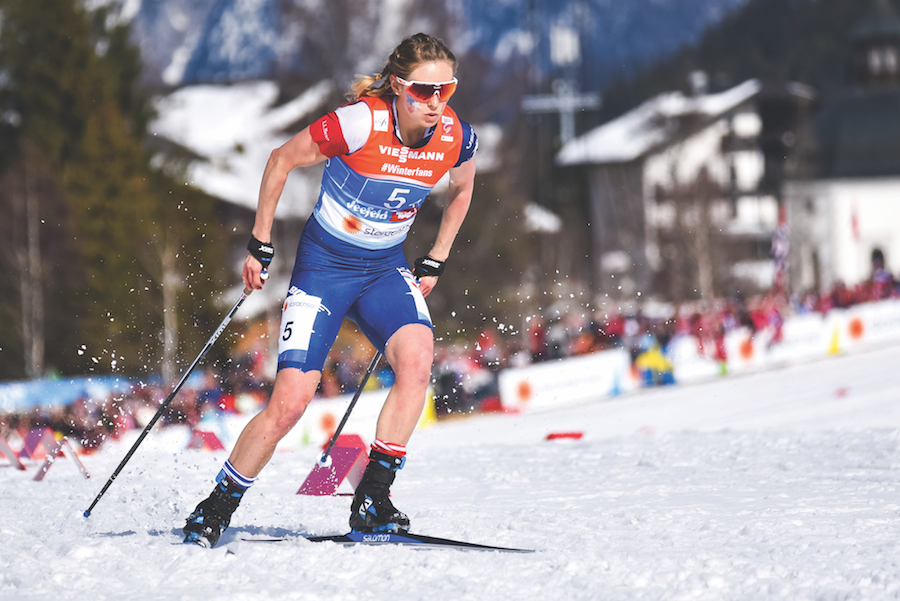
In December 2019, she earned three World Cup podiums: a bronze in the women’s 10k at Davos and two silvers at Lillehammer, in the skiathlon and the 4x5k relay. “I haven’t historically had great races [in Davos] because I take my time working into the season,” Diggins, who grew up in Minnesota, told the Minneaplois Star Tribune. “And this course is extremely difficult to pace. But this year, one of my goals was to come into the season a little closer to form than in the past, and it’s been awesome to feel like I’m in great shape while still working my way into top race form.”
And she’s had good company. Sophie Caldwell, daughter of former SMS T2 coach and Olympian Sverre Caldwell and his ski racing wife Lilly, and granddaughter of Olympian John Caldwell, was with Diggins on the podium as part of the third place 4×5 relay team in Lillehammer. She also made the podium in Davos, where she took third—in a photo finish it appeared she tied for second—in the sprint final and then, on Dec. 21, 2019, placed fourth in the sprint final at the next World Cup in Planica, Slovenia. With the season just kicking off, she stands to match or best her 2018/19 season where she earned three World Cup podiums.
For Caldwell, 2019 marked another big accomplishment: she married long-time partner and U.S. Ski Team teammate Simi Hamiltion, a three-time Olympian, who grew up in Aspen (his grandfather ran Aspen Mountain for three decades) and went to Middlebury College. Both her parents, ardent skiers, walked her down the aisle under the turning leaves in Peru, Vt., before her mother, who had been battling cancer, passed away in November.
Going into this season, Caldwell and Diggins will have an even stronger stable of teammates as Julia Kern and Sadie Bjornsen have also been posting strong finishes. The U.S. Women’s Cross Country dream team is going to be strong as ever.— L.G.
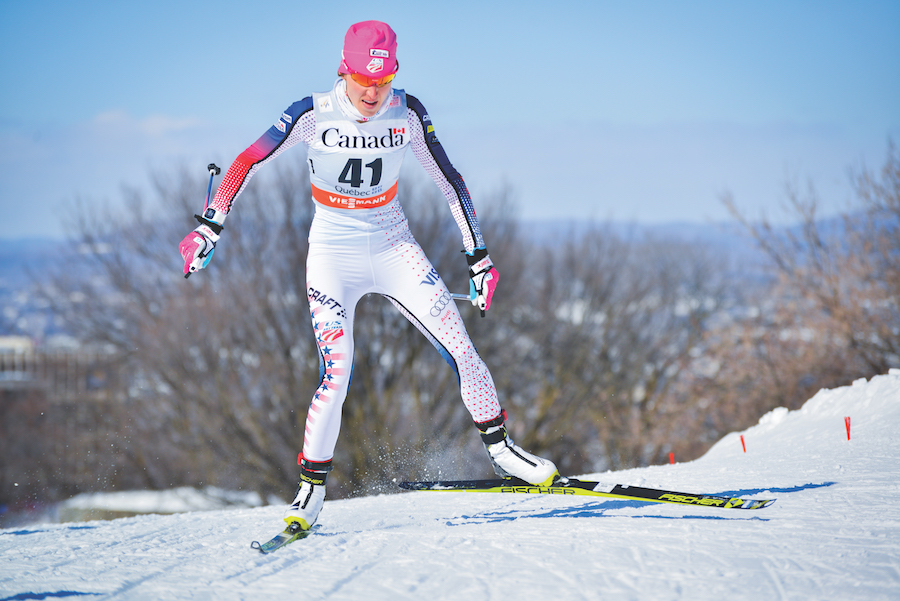
Ryan Cochran-Siegle, Starksboro, VT
Anyone who is still asking “but what about the men’s alpine ski team?” hasn’t followed what Ryan Cochran-Siegle has been up to this past year. While the U.S. has yet to turn out a male equivalent of a Mikaela Shiffrin or Lindsey Vonn, Siegle has been working his way up the ranks. Siegle, who grew up racing at Cochran’s Ski Area in Richmond under the tutelage of his mother, Olympic gold medalist Barbara Ann Cochran, seemed to have put injuries behind him in 2019 and began clawing his way up the ladder in World Cup races.
A supremely skilled technical skier, Siegle scored 21st in the World Championships in giant slalom in spring of 2019. He kicked off this season with an 11th in giant slalom at Soelden, Austria’s World Cup and on Dec. 23, was 12th in the parallel giant slalom in Alta Badia, Italy.
But recently he’s been upping his game in speed events too. After posting the fastest training run at the Birds of Prey Beaver Creek downhill World Cup in early December, Siegle placed sixth in the finals—the top American, followed by Steve Nyman, in 12th.
With teammates Ted Ligety and Tommy Ford also moving up the ranks, the men’s team may be poised to make a move this season. And Siegle will be right there. —L.G.
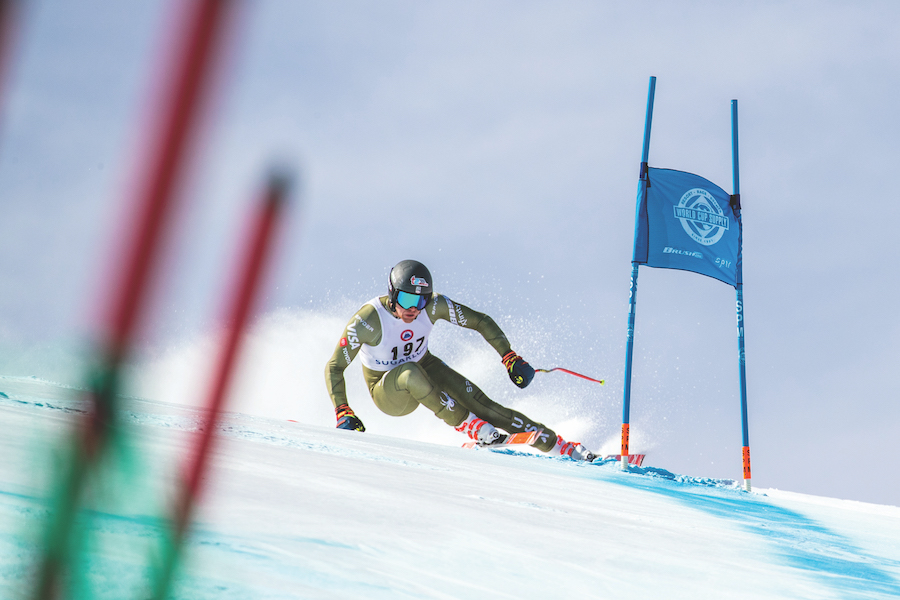
Cutline competes at the 2018-2019 U.S. Alpine Nationals. Photo by Jamie Walter
Lea Davison, Arlington, Vt.
In the past two years, it may have seemed like Lea Davison, 36, was chasing shadows. She was racing in the shadow of Kate Courtney, who at 22 won the 2018 UCI Mountain Bike World Championships in Lenzerheide, Switzerland—the same place where Davison earned the silver in the Worlds in 2016—her second World Championship medal.
At the 2019 Worlds in Mont St. Anne, Q.C., Courtney earned a fifth and Davison an 11th. By finishing in the top 8, Courtney has secured a spot in the 2022 Olympics, Davison—a two-time Olympian—is still having to fight for hers. And she’s had to do so without the support of her long-time sponsor, Specialized, which dropped her in 2017.
In some ways, Davison has also had to chase her own shadow, the long one she has cast as the leading lady of cross-country mountain biking and a contender, finishing 11th and seventh, respectively, at the 2012 and 2016 Olympics.
But with the 2020 Olympics coming up in Tokyo this summer, Davison is back. She’s now riding for Felt bikes as part of USA Cycling’s World Cup team and Sho-Air TWENTY20 team for domestic races. She’s also supported by Louis Garneau and is a brand ambassador for L.L. Bean.
Recently, she cut her hair, threw out her old bike kits, rebooted and changed up her training program and reset her energy. She began working full time with a nutritionist and strength trainer and filling in her winter fitness with Nordic skiing (Davison competed in Nordic at Middlebury College). And supporting her along the way was her wife, Frazier Blair, a senior VP at Orvis, who had competed as a ski racer at Williams College.
The two were married last summer in the Northeast Kingdom, wearing identical white kits made for them by sponsor Louis Garneau and spent Christmas vacation in Norway, cross-country skiing, part of what Davison has posted is her “Race Burnout Prevention Recipe.”
Then, it’s back to the grind and getting ready for the last Olympic qualifier: the World Cup opener in Nove Mesto, Czech Republic in May where the top 8 will secure Olympic spots. Davison will be there, fighting it out with Courtney and fellow U.S. teammates Erin Huck and Chloe Woodruff for what may be just two remaining spots. — L.G.
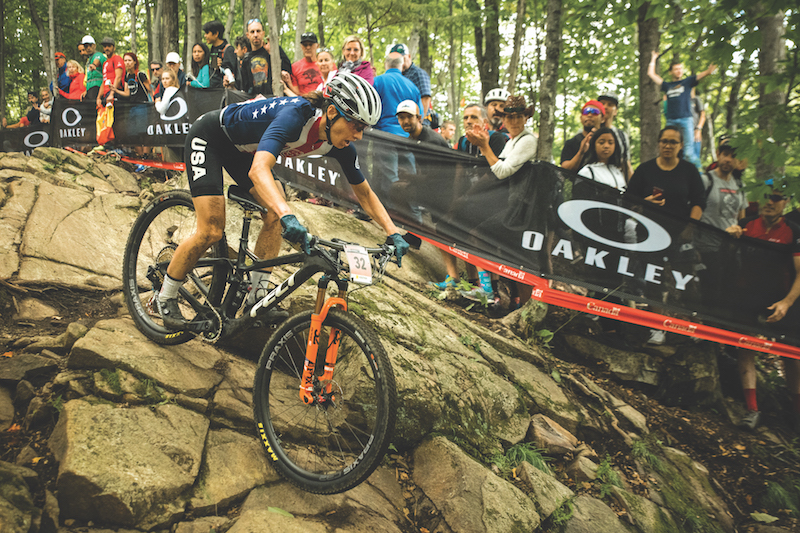
Mac Forehand, Winhall, Vt.
In 2019, Mac Forehand, then 17, got the invite that would make any teenager who’s into action sports, start fist-punching the air: for the first time the Stratton Mountain School freeskier was on the roster for the X Games in Aspen. However, in January he cracked his scapula, forcing him to sit out.
That didn’t stop Forehand from coming back with a vengeance. In March, at the Toyota U.S. Grand Prix at Mammoth Mountain, Calif., Forehand threw down a huge first run, scoring 90.95 to take the lead in slopestyle and earning his first World Cup gold medal. In November, 2018, he’d finished second at the World Cup in Stubai, Austria, then a fifth in the next World Cup in France.
By the time he reached the final World Cup in Silvaplan, Italy he’d amassed enough points that even with a 12th place finish there, he could win the overall crystal globe given to the season-long winners of the World Cup.
For a rookie U.S. Team member who had started the 2018-19 season by winning the Junior World Championships in big air in Cadrona, New Zealand, it was a whirlwind year.
“It feels crazy,” Forehand said at the press conference after the race. “I didn’t think I would have a chance to podium this year, nevermind take home the crystal globe at the end of the season. I want to thank all the guys back home at SMS (Stratton Mountain School) and U.S. Ski & Snowboard for supporting me all year long.”
Forehand is the only SMS student ever to win the overall World Cup while still at school.
Forehand, who grew up in Connecticut driving to his family’s ski house at Stratton every weekend, has been on coaches’ radars since he was a grom. He began competing in freestyle at age 12 and his family moved to Winhall, in part so he could train. “He’s just so smooth” says Jesse Mallis, the Stratton Mountain School coach who worked closely with Forehand, as he had with another World Cup globe winner, Devin Logan, on perfecting his big air jumps and slopestyle moves at Mount Snow’s Carinthia Parks.
Forehand kicked off his 2019/20 season with a 33rd in a big air World Cup in Italy, and then made it into the finals in Atlanta’s big air World Cup, held on a ramp covered with man-made snow at Sun Trust Park. However, he injured his knee and had to sit out the final run but still scored a 10th overall.
With big air skiing being introduced as a medal event at the Beijing Olympics in 2022, it’s a discipline Forehand is working on alongside his freestyle tricks. With sponsorship from Red Bull, Faction Skis and Carinthia Parks, this Stratton Mountain School student’s senior year looks bright. — L.G.
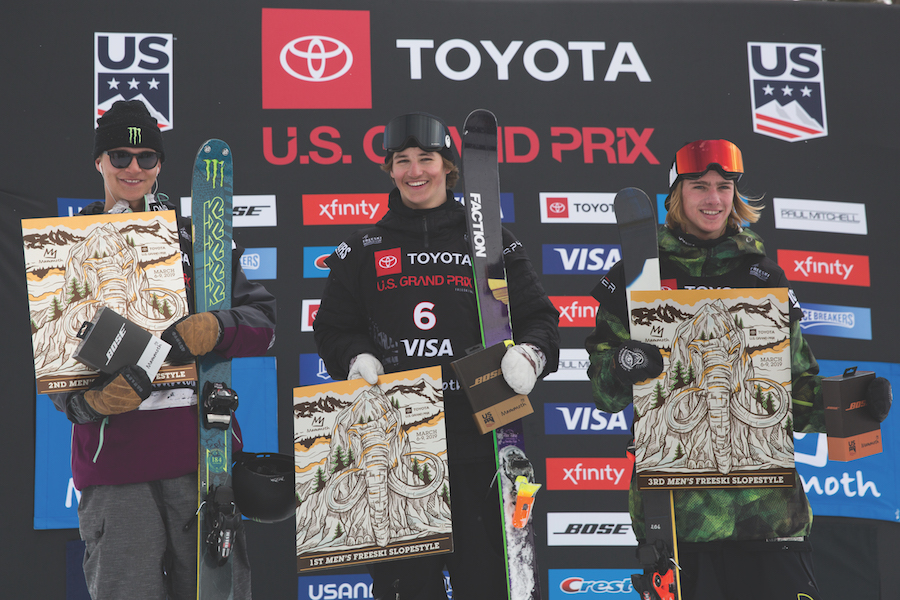
Geoff Gadbois, Milton, Vt.
At 24, 2022 Olympic hopeful Geoff Gadbois has taken, by his count, more than 2,000 bobsled runs.
Born and raised in Milton, Gadbois got his start in the junior bobsled program at Lake Placid, N.Y., at the age of 14. Since then, he’s put in some impressive finishes at World Cup and North American Cup events and on March 3, 2019, Gadbois piloted the two-man sled that earned Team USA a bronze at the International Bobsled and Skeleton Federation World Championships in Whistler, British Columbia.
During the race, Gadbois’ sled maxed out at 93 miles per hour to descend the 4,760-foot track in less than a minute.
It was a bold performance from a pilot who, just two days prior, had flipped his
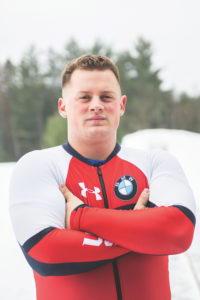
sled after entering a curve too late on the very same track. He and his teammate, push athlete Adrian Adams, slammed against the ice at 85 miles per hour, sliding, still in the sled, to the track’s base at such high speed that they yo-yo’ed back up the track and into the last curve before officials could extricate them. Both walked away.
“My wife and I were watching from Vermont,” recalls Geoff Gadbois senior, the athlete’s father. “It was 45 minutes before we got a text from him letting us know he was ok.”
The sport of bobsled is incredibly precise. Drivers win (or lose) the podium in the blink of an eye and the whole event takes place in less than a minute. It’s one of the Olympic speed sports that are timed down to a one hundredth of a second.
Divided into two events: four-man and two-man, a bobsled run starts with either one or three “push athletes,” some of the biggest, fastest sprinters on the planet, pushing a 300 to 500 pound sled as hard as they can for 50 yards before jumping on board and entering the luge. At that point, they put their faith in their pilot.
With as many as 22 turns to navigate in under a minute, the driver turns the sled by applying gentle pressure to its four rounded runners. The brake is never pulled until the track’s terminus, and the slightest imbalance in weight or movement can cause a craft to flip at speeds of up to 95 miles per hour.
“Crashing is not fun, but the only way to get over a crash is to get right back out there and drive the track again,” says Gadbois.
Gadbois also drove the sled that took first place in the four-man bobsled at a North American Cup event in Calgary, Canada, on January 10, 2019. The following day he took second place in the two-man at the same competition, and on Jan. 13, he took second place in the four-man bobsled in Calgary. And this past November, he took a third and fourth place finish in the two-man bobsled at a North American Cup event in Lake Placid.
“It was the speed that drew me in,” says Gadbois, a former lineman for Milton High School’s football team. He’s competed on Team USA since 2014 with several years of top 20 finishes at World Cup and National Championship events and the odd top five finish.
“I have had the opportunity to compete against Geoff for many years as well as coach him and his team during the past season,” says U.S. Bobsled Team coach Nick Cunningham. “He has transitioned from someone that is relatively unknown within the US program to someone who is known by name around the world.”
Currently, Gadbois is one of 12 athletes on the U.S. Bobsled Team, and one of only three pilots. All three are younger than 24, which bodes well for the team’s development over the next eight years. Pilots tend to get better with age, with athletes peaking in performance well into their thirties. “It takes years of experience and driving many tracks all over the world to become a good pilot. As a team, once you’ve got your start down and you’re driving at a high level, equipment really makes a difference in this sport,” Gadbois says. As of now, Gadbois is a serious contender for one of three spots on the Olympic team. “I’m really making a big push for the 2022 Olympics in Beijing,” he says.
The United States has not earned a gold medal in men’s bobsled since the 2010 Winter Olympics in Vancouver, when the late pilot Steve Holcomb, the most decorated American bobsledder of all time, earned a gold medal in the four-man bobsled—the first for an American man since the 1948 Olympics.
It was Holcomb who nicknamed Geoff Gadbois “50-50,” at the first Driver’s camp he participated in at age 15, says Gadbois father. Geoff Jr crashed 11 out of 22 runs on the track at Lake Placid—a notoriously challenging course. “It was a way of saying, hey, this kid has an intuitive ability to handle challenge in a very precise, very difficult situation. He may not be perfect yet, but he’s got gall, and there’s something there.”— A.G.
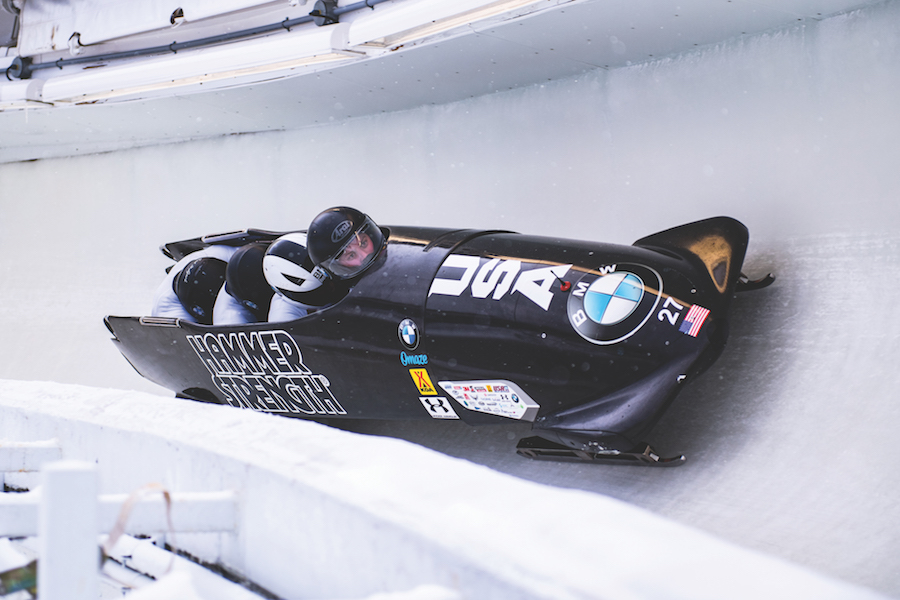
Tara Geraghty-Moats, West Fairlee, VT
For more than a year, Tara Geraghty-Moats has been what the Federation International du Ski (FIS) has called “the measuring stick for all Nordic Combined women, lending her voice and personality to a sport in which women have to make up for a lot of lost time.
In 2018/19, the first season of there even being a Nordic Combined Continental Cup for women, Geraghty-Moats won just about every event she entered, from Steamboat Springs, Colo. and Park City, Utah to events in Estonia and Russia.
In December, in Park City, Geraghty-Moats once again swept the first Nordic Combined Continental Cup event of the 2019/20 season.
In January, she will take time away from her dual-sport (Nordic combined and ski jumping) schedule to serve in an official capacity as an Athlete Role Model at the Youth Olympic Games in Lausanne, Switzerland, which will have a Nordic Combined event for women. Nordic Combined remains the only event not open to women in the regular Winter Olympics, something Geraghty-Moats has been campaigning to change. While it has yet to be named an Olympic sport, in 2020/21 there will be a World Cup in Nordic Combined for women.
What makes Geraghty-Moats mastery of this dual sport where your starting time in a cross-country ski race is determined by how well you fare in the ski jumping event, even more impressive is this: she’s simultaneously competing at the World Cup level as a ski jumper. That’s a feat akin to a rodeo rider also competing in steeplechase.
On Dec. 9, 2019, during a World Cup jump in Lillehammer, Norway, Geraghty-Moats got off balance after launching off the jump, her ski caught the air and she went crashing down. While the crash appeared horrific, sending her sliding down the sloped landing area, she suffered only a bruised hip and a sore rib. “I’ve honestly had worse injuries slipping on the ice in the parking lot,” she wrote on her social media pages.
A week later, she was back to winning the first Nordic Combined event of 2019/20 in Park City, Utah. —L.G.
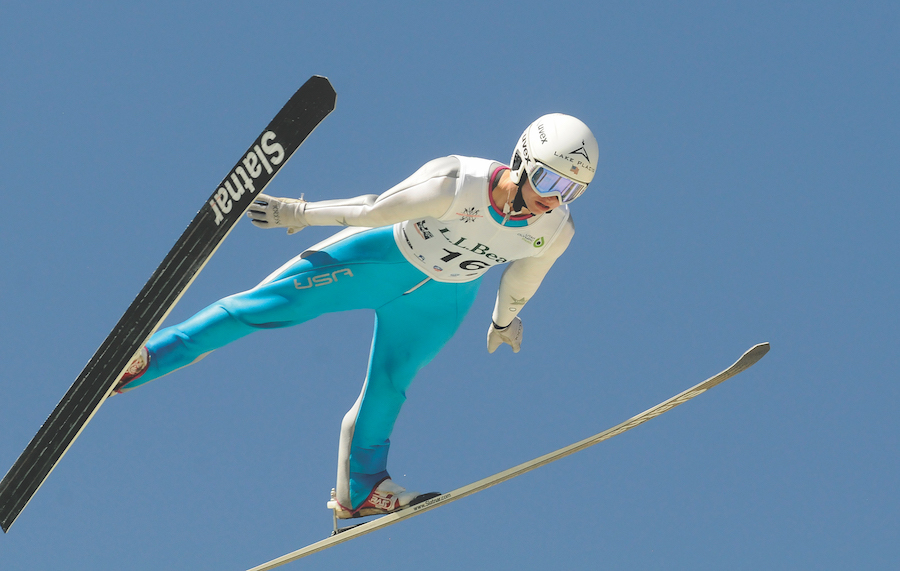
Nika Meyers, Bridgewater Corners, Vt.
It was a record-breaking year for speed attempts on The Long Trail. Between June and October, three people set new unsupported fastest-known-times (FKTs) on the 273-mile trail that bested a prior men’s record that had remained untouched for nine years.
One of those people was 30-year-old Nika Meyers of Bridgewater Corners.
On October 2, Meyers finished the trail in six days, 11 hours and 40 minutes. Her attempt was “Unsupported,” meaning she carried every piece of gear she used and each item of food in a pack on her back. The only thing she picked up along the way was water.
“There was no ‘unsupported’ record for a female hiker, so I used Jennifer Pharr Davis’ 2007 self-supported (meaning she cached food ahead of time at stops along the way) record of 7 days 15 hours and 40 minutes,” said Meyers. In 2018, Meyers also completed the Triple Crown of American long distance hiking trails: the 2,650-mile Pacific Crest Trail, the 2,200-mile Appalachian Trail and the 3,100-mile Continental Divide Trail.
“I wanted to try experiencing the Long Trail in a new way,” Myers said of this thru-hike. “I averaged about 42 miles per day and hiked from about 3:30 a.m. to 9:30 or 10 p.m., aiming for a minimum of five hours of sleep every night,” she said. Instead of setting firm mileage days based on other FKTers’ progress before her, she set out to take the notoriously rugged trail day by day—hiking until her body told her to stop. “I wanted to see what I could do.”
Though she only did the occasional weekend day hike over the summer, Meyers, like the two men who also scored unsupported FKTs on the Long Trail
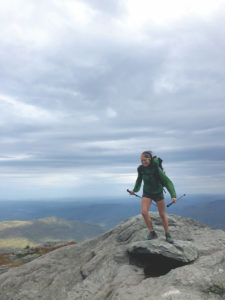
this summer, beat Travis Wildeboer’s 2010 time of 6 days, 17 hours and 45 seconds—a record that remained untouched despite many attempts over the past nine years.
This summer, Josh Perry, a 24-year-old hiker from Yorkshire, England hiked the trail unsupported in 6 days, 9 hours and 48 minutes to finish on June 13. He held the record for just a short while, as Jeff “Legend” Garmire, a 28-year-old ultrarunner from Colorado hiked it in a blistering 5 days, 23 hours and 48 minutes to finish on July 24.
As Pharr Davis said of Meyers’ feat, “There are very few who can appreciate the demands of a six-day unsupported thru-hike on The Long Trail. As someone who has come close to her mark, I consider her efforts nothing short of Olympian.”
Meyers also, in her first attempt at an FKT, broke a men’s record that had stood for 10 full years. In the world of FKTs on long-distance trails, men and women have historically competed in separate time categories. Hikers like Meyers are closing that gap.
“Nika Meyers is one of my heroes,” says Pharr Davis. “She pours herself into conservation and outdoor education with the same passion and intensity that she used to set a FKT. She is a wonderful example of someone who has given back to the trails that have given her so much.” —A.G.
Featured Photo Caption: Mac Forehand finds big air close to home at Carinthia Parks. Mike Dawsey.

